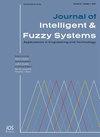A novel ensemble learning approach for fault detection of sensor data in cyber-physical system
IF 1
4区 计算机科学
Q3 COMPUTER SCIENCE, ARTIFICIAL INTELLIGENCE
引用次数: 0
Abstract
Cyber-physical systems (CPS) play a pivotal role in various critical applications, ranging from industrial automation to healthcare monitoring. Ensuring the reliability and accuracy of sensor data within these systems is of paramount importance. This research paper presents a novel approach for enhancing fault detection in sensor data within a cyber-physical system through the integration of machine learning algorithms. Specifically, a hybrid ensemble methodology is proposed, combining the strengths of AdaBoost and Random Forest with Rocchio’s algorithm, to achieve robust and accurate fault detection. The proposed approach operates in two phases. In the first phase, AdaBoost and Random Forest classifiers are trained on a diverse dataset containing normal and faulty sensor data to develop individual base models. AdaBoost emphasizes misclassified instances, while Random Forest focuses on capturing complex interactions within the data. In the second phase, the outputs of these base models are fused using Rocchio’s algorithm, which exploits the similarities between faulty instances to improve fault detection accuracy. Comparative analyses are conducted against individual classifiers and other ensemble methods to validate the effectiveness of the hybrid approach. The results demonstrate that the proposed approach achieves superior fault detection rates. Additionally, the integration of Rocchio’s algorithm significantly contributes to the refinement of the fault detection process, effectively leveraging the strengths of AdaBoost and Random Forest. In conclusion, this research offers a comprehensive solution to enhance fault detection capabilities in cyber-physical systems by introducing a novel ensemble framework. By synergistically combining AdaBoost, Random Forest, and Rocchio’s algorithm, the proposed methodology provides a robust mechanism for accurately identifying sensor data anomalies, thus bolstering the reliability and performance of cyber-physical systems across a multitude of critical applications.网络物理系统中传感器数据故障检测的集成学习方法
信息物理系统(CPS)在从工业自动化到医疗监控等各种关键应用中发挥着关键作用。确保这些系统中传感器数据的可靠性和准确性至关重要。本文提出了一种通过集成机器学习算法来增强网络物理系统中传感器数据故障检测的新方法。具体而言,提出了一种混合集成方法,将AdaBoost和Random Forest的优点与Rocchio算法相结合,以实现鲁棒性和准确性的故障检测。拟议的方法分两个阶段进行。在第一阶段,AdaBoost和Random Forest分类器在包含正常和故障传感器数据的不同数据集上进行训练,以开发单独的基本模型。AdaBoost强调错误分类的实例,而Random Forest侧重于捕获数据中的复杂交互。在第二阶段,使用Rocchio算法融合这些基本模型的输出,该算法利用故障实例之间的相似性来提高故障检测的准确性。通过与个体分类器和其他集成方法的对比分析,验证了混合方法的有效性。结果表明,该方法具有较高的故障检测率。此外,Rocchio算法的集成显著有助于改进故障检测过程,有效地利用AdaBoost和随机森林的优势。总之,本研究通过引入一种新颖的集成框架,为增强网络物理系统的故障检测能力提供了一种全面的解决方案。通过将AdaBoost、Random Forest和Rocchio算法协同结合,所提出的方法为准确识别传感器数据异常提供了强大的机制,从而提高了网络物理系统在众多关键应用中的可靠性和性能。
本文章由计算机程序翻译,如有差异,请以英文原文为准。
求助全文
约1分钟内获得全文
求助全文
来源期刊

Journal of Intelligent & Fuzzy Systems
工程技术-计算机:人工智能
CiteScore
3.40
自引率
10.00%
发文量
965
审稿时长
5.1 months
期刊介绍:
The purpose of the Journal of Intelligent & Fuzzy Systems: Applications in Engineering and Technology is to foster advancements of knowledge and help disseminate results concerning recent applications and case studies in the areas of fuzzy logic, intelligent systems, and web-based applications among working professionals and professionals in education and research, covering a broad cross-section of technical disciplines.
 求助内容:
求助内容: 应助结果提醒方式:
应助结果提醒方式:


